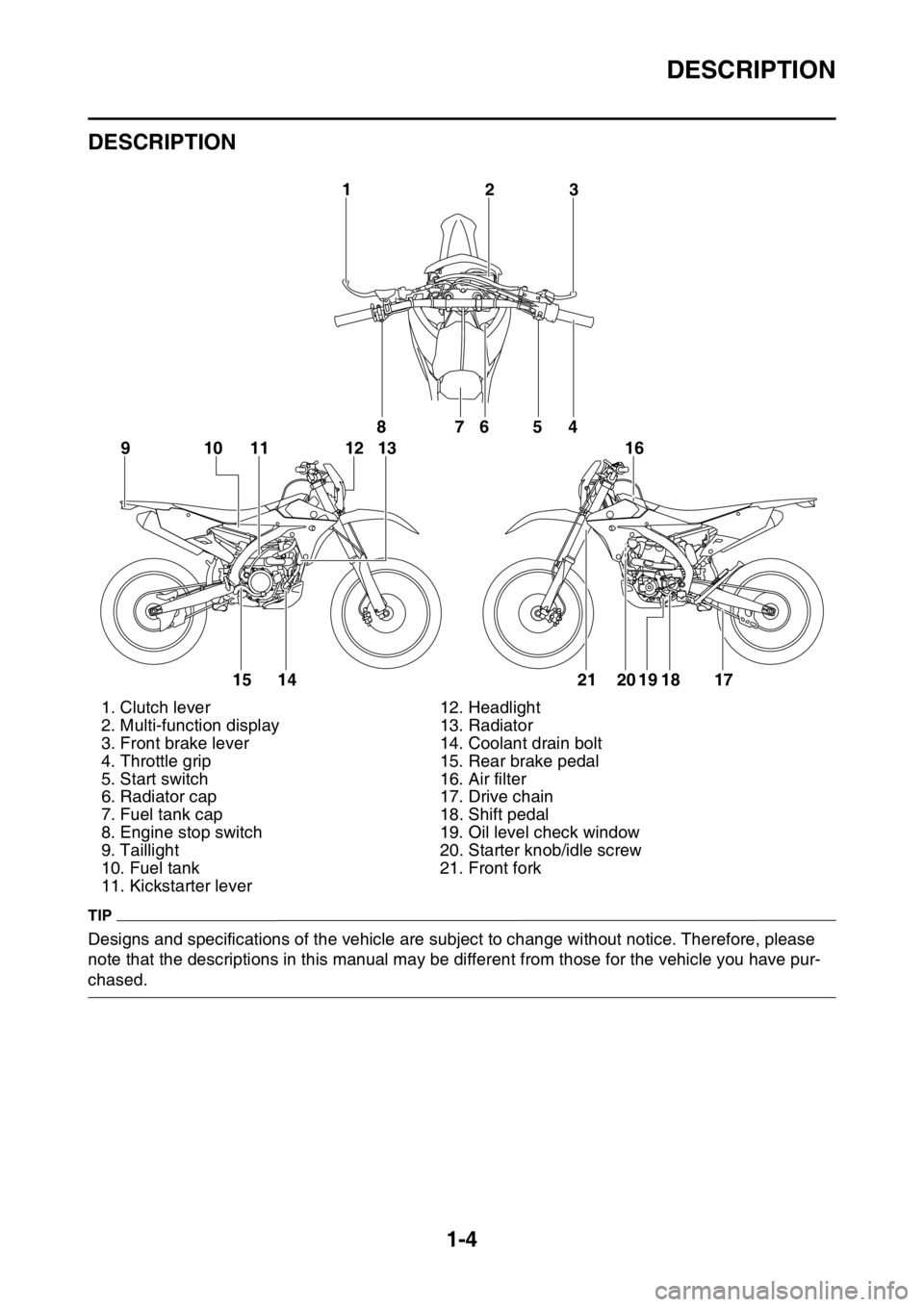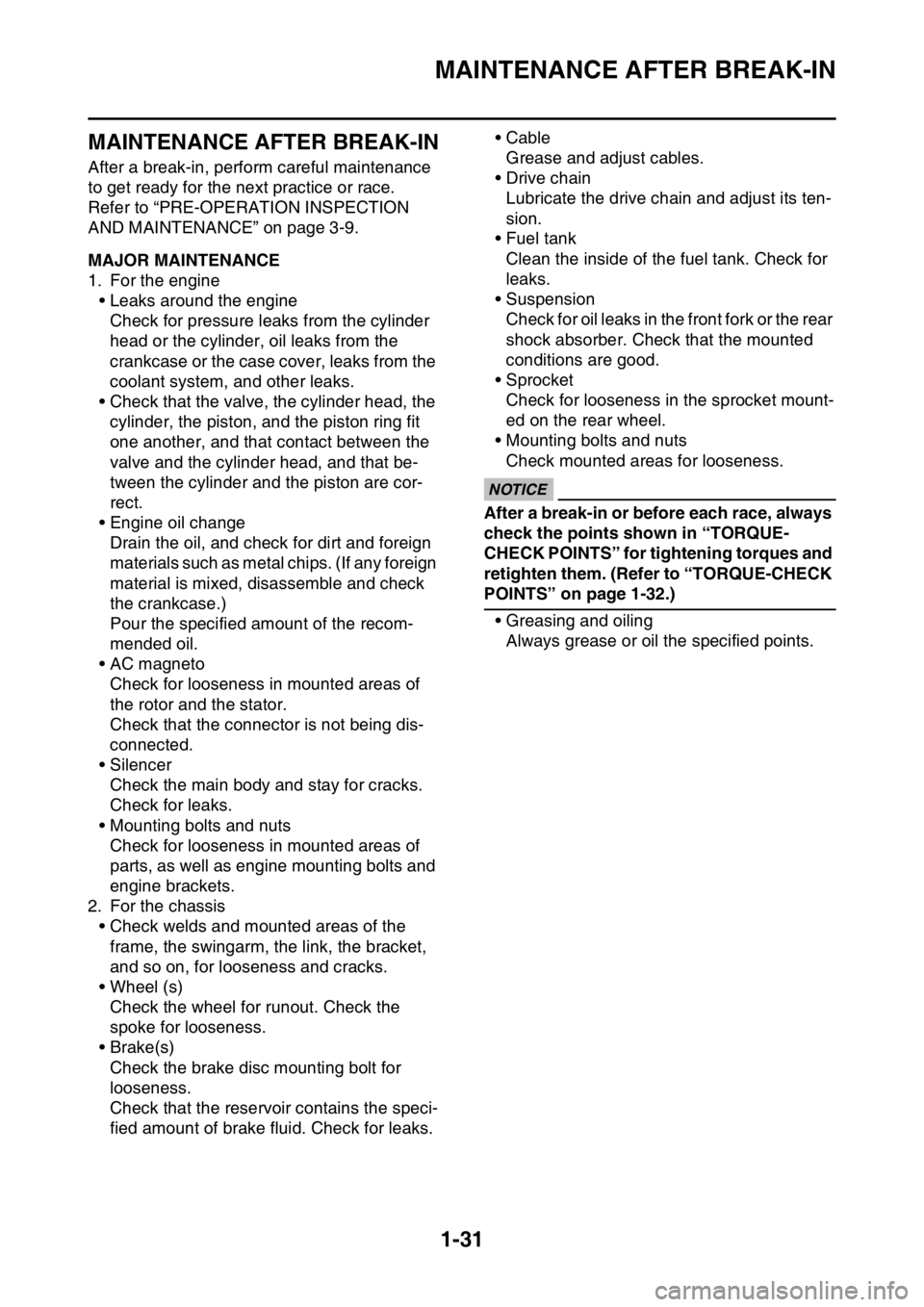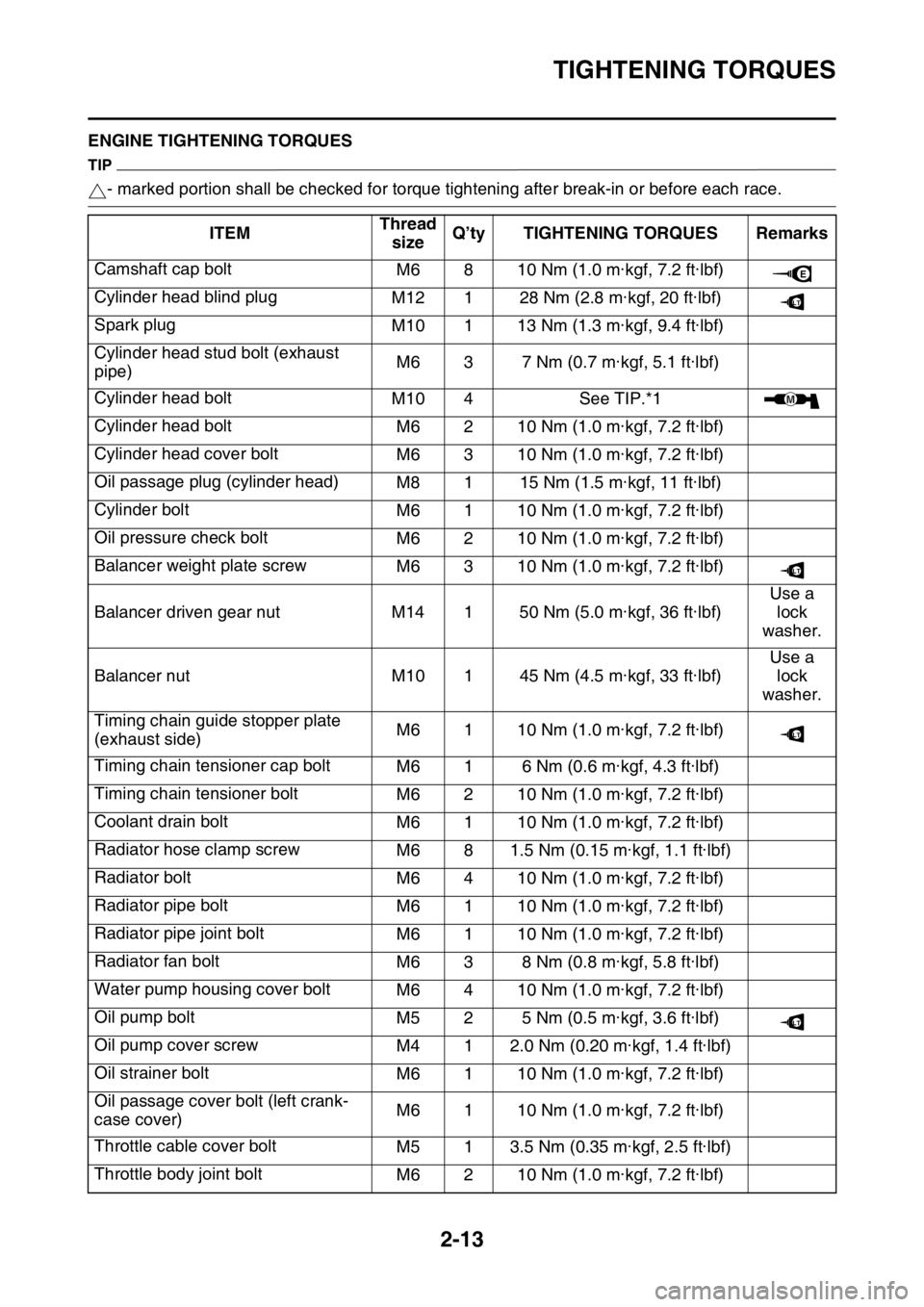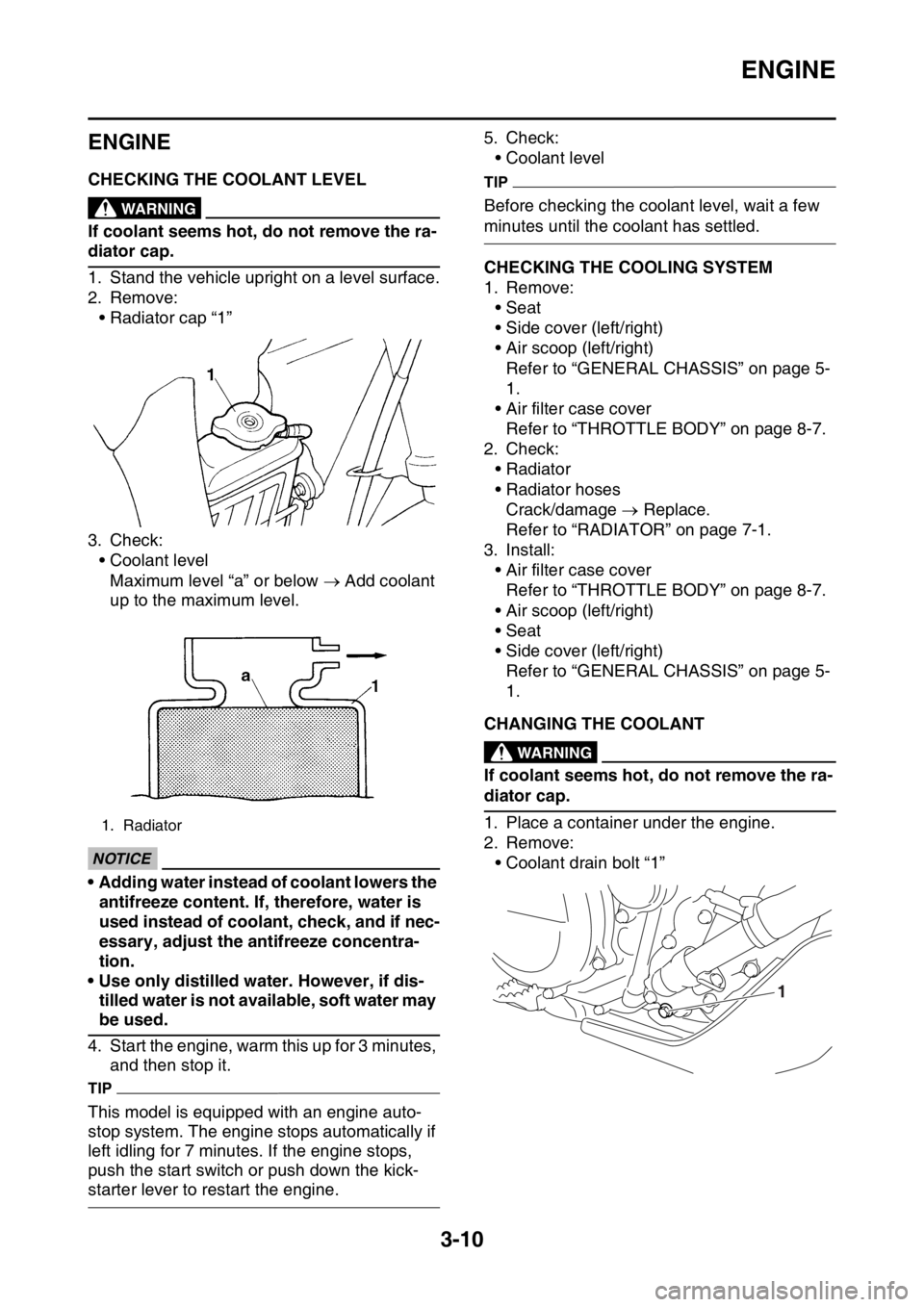engine coolant YAMAHA WR 450F 2016 Owners Manual
[x] Cancel search | Manufacturer: YAMAHA, Model Year: 2016, Model line: WR 450F, Model: YAMAHA WR 450F 2016Pages: 426, PDF Size: 10.86 MB
Page 18 of 426

DESCRIPTION
1-4
EAS2GC1009
DESCRIPTION
TIP
Designs and specifications of the vehicle are subject to change without notice. Therefore, please
note that the descriptions in this manual may be different from those for the vehicle you have pur-
chased.1. Clutch lever 12. Headlight
2. Multi-function display 13. Radiator
3. Front brake lever 14. Coolant drain bolt
4. Throttle grip 15. Rear brake pedal
5. Start switch 16. Air filter
6. Radiator cap 17. Drive chain
7. Fuel tank cap 18. Shift pedal
8. Engine stop switch 19. Oil level check window
9. Taillight 20. Starter knob/idle screw
10. Fuel tank 21. Front fork
11. Kickstarter lever
32
1
8
10
91 112 1376
54
15 14 21 20 19 18 17 16
Page 21 of 426

IMPORTANT INFORMATION
1-7
EAS20180
IMPORTANT INFORMATION
EAS2GC1020PREPARATION FOR REMOVAL AND DIS-
ASSEMBLY
1. Before the jobs, completely remove mud, dust, and the like in order to prevent the en-
try of them into the inside during the jobs.
• Before cleaning with high-pressure water of washers, cover the following parts.
Air duct
Silencer exhaust port
Drain hole on the cylinder head (right side)
Hole under the water pump housing
2. Use proper special tools and equipment. See “SPECIAL TOOLS”.
3. During disassembly, check and measure the required parts, and make a record of them
so that you may refer to the record when in-
stalling them. Moreover, arrange gears, cyl-
inders, pistons, and other parts for each
section so as not to confuse or lose them. 4. During disassembly, clean each of the parts,
and store them in trays for each section.
5. Flammable. Keep servicing areas away from any source of fire.
6. During servicing, take special care not to re-
ceive an injury or a burn on the engine, the
exhaust pipe, the silencer, or the like.
7. If coolant is left adhered to the chassis, paint
and plating will be damaged. Therefore,
rinse it out with water in good time.
EWA
WARNING
Coolant is potentially harmful and should
be handled with special care.
• If it enters your eyes, wash it away with wa-ter enough and then get medical attention
• If it splashes on your skin or clothes,
quickly wash it away with water and then
with soapy water.
• If it is swallowed, immediately induce vom-
iting and get medical attention.
EAS2GC1021REPLACEMENT PARTS
Make sure that the parts and grease or oil to be
used for repair of the vehicle, including periodic
replacement parts, are new YAMAHA genuine
parts and recommended parts.
Do not use any used parts, because these may
not be genuine though they have similar ap-
pearances or because the quality may be
changed by aging.
Page 45 of 426

MAINTENANCE AFTER BREAK-IN
1-31
EAS2GC1055
MAINTENANCE AFTER BREAK-IN
After a break-in, perform careful maintenance
to get ready for the next practice or race.
Refer to “PRE-OPERATION INSPECTION
AND MAINTENANCE” on page 3-9.
EAS2GC1056MAJOR MAINTENANCE
1. For the engine• Leaks around the engineCheck for pressure l eaks from the cylinder
head or the cylinder, oil leaks from the
crankcase or the case cover, leaks from the
coolant system, and other leaks.
• Check that the valve, the cylinder head, the cylinder, the piston, and the piston ring fit
one another, and that contact between the
valve and the cylinder head, and that be-
tween the cylinder and the piston are cor-
rect.
• Engine oil change Drain the oil, and check for dirt and foreign
materials such as metal chips. (If any foreign
material is mixed, disassemble and check
the crankcase.)
Pour the specified amount of the recom-
mended oil.
• AC magneto
Check for looseness in mounted areas of
the rotor and the stator.
Check that the connector is not being dis-
connected.
• Silencer Check the main body and stay for cracks.
Check for leaks.
• Mounting bolts and nuts Check for looseness in mounted areas of
parts, as well as engine mounting bolts and
engine brackets.
2. For the chassis
• Check welds and mounted areas of the frame, the swingarm, the link, the bracket,
and so on, for looseness and cracks.
• Wheel (s) Check the wheel for runout. Check the
spoke for looseness.
• Brake(s) Check the brake disc mounting bolt for
looseness.
Check that the reservoir contains the speci-
fied amount of brake fluid. Check for leaks. • Cable
Grease and adjust cables.
•Drive chain
Lubricate the drive chain and adjust its ten-
sion.
• Fuel tank
Clean the inside of the fuel tank. Check for
leaks.
• Suspension
Check for oil leaks in the front fork or the rear
shock absorber. Check that the mounted
conditions are good.
• Sprocket Check for looseness in the sprocket mount-
ed on the rear wheel.
• Mounting bolts and nuts
Check mounted areas for looseness.
ECA
NOTICE
After a break-in or before each race, always
check the points shown in “TORQUE-
CHECK POINTS” for tightening torques and
retighten them. (Refer to “TORQUE-CHECK
POINTS” on page 1-32.)
• Greasing and oilingAlways grease or oil the specified points.
Page 57 of 426

ENGINE SPECIFICATIONS
2-6
Fuel pumpPump type Electrical
Fuel injector
Model/quantity 1010/1
Resistance 12
Throttle body
Type/quantity 30RA-A05U/1
ID mark 2GC1 00
Fuel line pressure (at idle) 300.0–390.0 kPa (3.00–3.90 kgf/cm
2, 43.5–
56.6 psi)
Throttle position sensor Resistance 6.30 k
Output voltage (at idle) 0.48–0.52 V
Fuel injection sensor Crankshaft position sensor resistance 228–342
Intake air pressure sensor output voltage 3.61–3.67 V at 101.3 kPa (3.61–3.67 V at 1.01 kgf/cm
2, 3.61–3.67 V at 14.7 psi)
Intake air temperature sensor resistance 290–390 at 80 °C (290–390 at 176 °F)
Coolant temperature sensor resistance 2512–2777 at 20 °C (2512–2777 at 68 °F)
210–220 at 100 °C (210–220 at 212 °F)
Idling condition
Engine idling speed 1900–2100 r/min
CO% 3.5–4.5 % (USA) (CAN)
Intake vacuum 32.8–36.8 kPa (246–276 mmHg, 9.7–10.9 inHg) (USA) (CAN)
Water temperature 70–90 °C (158–194 °F)
Oil temperature 70–80 °C (158–176 °F)
Throttle grip free play 3.0–6.0 mm (0.12–0.24 in)
Page 64 of 426

TIGHTENING TORQUES
2-13
EAS2GC1066ENGINE TIGHTENING TORQUES
TIP
- marked portion shall be checked for torque tightening after break-in or before each race.
ITEM Thread
size Q’ty TIGHTENING TORQUES Remarks
Camshaft cap bolt M6 8 10 Nm (1.0 m·kgf, 7.2 ft·lbf)
Cylinder head blind plug M12 1 28 Nm (2.8 m·kgf, 20 ft·lbf)
Spark plug M10 1 13 Nm (1.3 m·kgf, 9.4 ft·lbf)
Cylinder head stud bolt (exhaust
pipe) M6 3 7 Nm (0.7 m·kgf, 5.1 ft·lbf)
Cylinder head bolt M10 4See TIP.*1
Cylinder head bolt M6 2 10 Nm (1.0 m·kgf, 7.2 ft·lbf)
Cylinder head cover bolt M6 3 10 Nm (1.0 m·kgf, 7.2 ft·lbf)
Oil passage plug (cylinder head) M8 1 15 Nm (1.5 m·kgf, 11 ft·lbf)
Cylinder bolt M6 1 10 Nm (1.0 m·kgf, 7.2 ft·lbf)
Oil pressure check bolt M6 2 10 Nm (1.0 m·kgf, 7.2 ft·lbf)
Balancer weight plate screw M6 3 10 Nm (1.0 m·kgf, 7.2 ft·lbf)
Balancer driven gear nut M14 1 50 Nm (5.0 m·kgf, 36 ft·lbf) Use a
lock
washer.
Balancer nut M10 1 45 Nm (4.5 m·kgf, 33 ft·lbf) Use a
lock
washer.
Timing chain guide stopper plate
(exhaust side) M6 1 10 Nm (1.0 m·kgf, 7.2 ft·lbf)
Timing chain tensioner cap bolt M6 1 6 Nm (0.6 m·kgf, 4.3 ft·lbf)
Timing chain tensioner bolt M6 2 10 Nm (1.0 m·kgf, 7.2 ft·lbf)
Coolant drain bolt M6 1 10 Nm (1.0 m·kgf, 7.2 ft·lbf)
Radiator hose clamp screw M6 8 1.5 Nm (0.15 m·kgf, 1.1 ft·lbf)
Radiator bolt M6 4 10 Nm (1.0 m·kgf, 7.2 ft·lbf)
Radiator pipe bolt M6 1 10 Nm (1.0 m·kgf, 7.2 ft·lbf)
Radiator pipe joint bolt M6 1 10 Nm (1.0 m·kgf, 7.2 ft·lbf)
Radiator fan bolt M6 3 8 Nm (0.8 m·kgf, 5.8 ft·lbf)
Water pump housing cover bolt M6 4 10 Nm (1.0 m·kgf, 7.2 ft·lbf)
Oil pump bolt M5 2 5 Nm (0.5 m·kgf, 3.6 ft·lbf)
Oil pump cover screw M4 1 2.0 Nm (0.20 m·kgf, 1.4 ft·lbf)
Oil strainer bolt M6 1 10 Nm (1.0 m·kgf, 7.2 ft·lbf)
Oil passage cover bolt (left crank-
case cover) M6 1 10 Nm (1.0 m·kgf, 7.2 ft·lbf)
Throttle cable cover bolt M5 1 3.5 Nm (0.35 m·kgf, 2.5 ft·lbf)
Throttle body joint bolt M6 2 10 Nm (1.0 m·kgf, 7.2 ft·lbf)
E
LT
M
LT
LT
LT
Page 97 of 426

3
PERIODIC CHECKS AND ADJUSTMENTS
PERIODIC MAINTENANCE............................................................................. 3-1
INTRODUCTION ........................................................................................ 3-1
PERIODIC MAINTENANCE CHART FOR THE EMISSION
CONTROL SYSTEM ....................... .......................................................... 3-1
GENERAL MAINTENANCE AND LUBRICATION CHART ........................ 3-2
MAINTENANCE INTERVALS FOR COMPETITION USE ......................... 3-4
PRE-OPERATION INSPECTION AND MAINTENANCE ................................. 3-9
GENERAL INSPECTION AND MAINTENANCE........................................ 3-9
ENGINE .......................................................................................................... 3-10
CHECKING THE COOLANT LEVEL ........................................................ 3-10
CHECKING THE COOLING SYSTEM ..................................................... 3-10
CHANGING THE COOLANT.................................................................... 3-10
CHECKING THE RADIATOR CAP .......................................................... 3-11
CHECKING THE RADIATOR CAP VALVE OPENING PRESSURE ....... 3-11
CHECKING THE COOLANT CIRCULATORY SYSTEM FOR LEAKS .... 3-12
ADJUSTING THE CLUTCH LEVER FREE PLAY .................................... 3-12
ADJUSTING THE THROTTLE GRIP FREE PLAY .................................. 3-13
LUBRICATING THE THROTTLE CABLE ................................................ 3-14
CLEANING THE AIR FILTER ELEMENT................................................. 3-14
CHECKING THE THROTTLE BODY JOINT ............................................ 3-15
CHECKING THE BREATHER HOSES .................................................... 3-15
CHECKING THE EXHAUST SYSTEM............................. ........................ 3-15
CHECKING THE FUEL LINE ................................................................... 3-16
CHECKING THE ENGINE OIL LEVEL............................. ........................ 3-16
CHANGING THE ENGINE OIL ................................................................ 3-17
ADJUSTING THE ENGINE IDLING SPEED ......... ................................... 3-19
ADJUSTING THE VALVE CLEARANCE ................................................. 3-20
CLEANING THE SPARK ARRESTER ..................................................... 3-24
CHASSIS ........................................................................................................ 3-25
BLEEDING THE BRAKE SYST EM .......................................................... 3-25
CHECKING THE BRAKE HOSE .............................................................. 3-26
ADJUSTING THE FRONT BRAKE .......................................................... 3-26
ADJUSTING THE REAR BRAKE ............................................................. 3-27
CHECKING THE FRONT BR AKE PADS ................................................. 3-27
CHECKING THE REAR BRAKE PADS ........................... ........................ 3-29
CHECKING THE REAR BRAKE PAD INSULATOR ................................ 3-30
CHECKING THE BRAKE FLUID LEVEL.................................................. 3-30
ADJUSTING THE DRIVE CHAIN SLACK ................................................ 3-31
CHECKING THE FRONT FORK LEGS ................................................... 3-31
CHECKING THE FRONT FORK PROTECTOR GUIDE .......................... 3-32
CLEANING THE FRONT FORK OI L SEAL AND DUST SEAL ................ 3-32
AIR BLEEDING FROM FRONT FORK .................................................... 3-32
ADJUSTING THE FRONT FORK LEGS .................................................. 3-33
CHECKING THE SWINGARM OPERATION ........................................... 3-34
CHECKING THE REAR SUSPENSION ................................................... 3-34
Page 104 of 426

PERIODIC MAINTENANCE
3-6
COOLING SYSTEMCheck coolant lev-
el and leakage
Check radiator cap
operation
Replace coolant Every two years
Inspect hoses
OUTSIDE NUTS
AND BOLTS
Retighten Refer to “STARTING AND
BREAK-IN” on page 1-28.
AIR FILTER
Clean and lubri-
cate Use Yamaha foam air filter oil
or other quality foam air filter
oil.
Replace
OIL FILTER
Replace
ENGINE GUARD Replace Breakage
FRAME Clean and inspect
FUEL TANK, FUEL
PUMP
Clean and inspect
FUEL HOSE Inspect
Replace Every four years
ITEM
After
break- in Every
race Every
third (or
500
km) Every
fifth (or
1,000 km) As re-
quired Remarks
Page 107 of 426

PRE-OPERATION INSPECTION AND MAINTENANCE
3-9
EAS2GC1079
PRE-OPERATION INSPECTION AND MAINTENANCE
Before riding for break-in operation, practice or a race, make sure the machine is in good operating
condition.
Before using this machine, check the following points.
EAS2GC1080GENERAL INSPECTION AND MAINTENANCE
TIP
Perform usual maintenance enough so that, in the race course, a confirmation of that and simple set-
ting adjustments may only be left, in order to get enough time to use effectively.ITEM inspect Page
Coolant Check that coolant is filled up to the radiator cap.
Check the cooling system for leakage. 3-10 – 12
Fuel Check that a fresh gasoline is filled in the fuel tank.
Check the fuel line for leakage. 1-28
Engine oil Check that the oil level is correct. Check the crank-
case and oil line for leakage. 3-16 – 18
Gear shifter and clutch Check that gears can be shifted correctly in order and
that the clutch operates smoothly. 3-12 – 13
Throttle grip/Housing Check that the throttle grip operation and free play
are correctly adjusted. Lubricate the throttle grip and
housing, if necessary. 3-13 – 14
Brakes Check the play of front brake and effect of front and
rear brake. 3-25 – 31
Drive chain Check drive chain slack and alignment. Check that
the drive chain is lubricated properly. 3-31
5-69 – 70
Wheels Check for excessive wear and tire pressure. Check
for loose spokes and have no excessive play. 3-36 – 37
Steering Check that the handlebar can be turned smoothly and
have no excessive play. 3-37 – 38
Front forks and rear
shock absorber Check that they operate smoothly and there is no oil
leakage.
3-31 – 36
Cables (wires) Check that the clutch and throttle cables move
smoothly. Check that they are not caught when the
handlebars are turned or when the front forks travel
up and down.
—
Exhaust pipe Check that the exhaust pipe is tightly mounted and
has no cracks. 3-15 – 16
Rear wheel sprocket Check that the rear wheel sprocket tightening bolt is
not loose. 5-10 – 11
Lubrication Check for smooth operation. Lubricate if necessary. 3-14
3-38 – 39
Bolts and nuts Check the chassis and engine for loose bolts and
nuts. 1-32 – 33
Lead connectors Check that the AC magneto, ECU and ignition coil are
connected tightly. 1-9 – 12
Settings Is the machine set suitably for the condition of the rac-
ing course and weather or by taking into account the
results of test runs before racing? Are inspection and
maintenance completely done?
4-1 – 8
Page 108 of 426

ENGINE
3-10
EAS2GC1081
ENGINE
EAS2GC1082CHECKING THE COOLANT LEVELEWA
WARNING
If coolant seems hot, do not remove the ra-
diator cap.
1. Stand the vehicle upright on a level surface.
2. Remove:• Radiator cap “1”
3. Check: • Coolant levelMaximum level “a” or below Add coolant
up to the maximum level.
ECA
NOTICE
• Adding water instead of coolant lowers the
antifreeze content. If, therefore, water is
used instead of coolant, check, and if nec-
essary, adjust the antifreeze concentra-
tion.
• Use only distilled water. However, if dis- tilled water is not available, soft water may
be used.
4. Start the engine, warm this up for 3 minutes, and then stop it.
TIP
This model is equipped with an engine auto-
stop system. The engine stops automatically if
left idling for 7 minutes. If the engine stops,
push the start switch or push down the kick-
starter lever to restart the engine. 5. Check:
• Coolant level
TIP
Before checking the coolant level, wait a few
minutes until the coolant has settled.
EAS2GC1083CHECKING THE COOLING SYSTEM
1. Remove:• Seat
• Side cover (left/right)
• Air scoop (left/right)Refer to “GENERAL CHASSIS” on page 5-
1.
• Air filter case cover Refer to “THROTTLE BODY” on page 8-7.
2. Check:
• Radiator
• Radiator hosesCrack/damage Replace.
Refer to “RADIATOR” on page 7-1.
3. Install: • Air filter case cover
Refer to “THROTTLE BODY” on page 8-7.
• Air scoop (left/right)
• Seat
• Side cover (left/right) Refer to “GENERAL CHASSIS” on page 5-
1.
EAS2GC1084CHANGING THE COOLANTEWA
WARNING
If coolant seems hot, do not remove the ra-
diator cap.
1. Place a container under the engine.
2. Remove:• Coolant drain bolt “1”
1. Radiator
1
Page 109 of 426

ENGINE
3-11
3. Remove:• Radiator capSlowly loosen the radiator cap to drain cool-
ant.
TIP
When the radiator cap is loosened, coolant will
gush out transversely; therefore, bring the con-
tainer near to the outlet.
4. Thoroughly flush the cooling system with
clean tap water.
5. Install:
• Copper washer
• Coolant drain bolt
6. Pour coolant.
EWA
WARNING
• If coolant splashes in your eyes, thorough- ly wash them with water and consult a
doctor.
• If coolant splashes on your clothes, quick-
ly wash it away with water and then with
soap and water.
• If coolant is swallowed, induce vomiting
and get immediate medical attention.
ECA
NOTICE
• Adding water instead of coolant lowers the
antifreeze content of the coolant. If water
is used instead of coolant check, and if
necessary, correct the antifreeze concen-
tration of the coolant.
• Use only distilled water. However, if dis-
tilled water is not available, soft water may
be used.
• If coolant comes into contact with painted
surfaces, immediately wash them with wa-
ter.
• Do not mix different types of antifreeze.
7. Install:• Radiator cap 8. Start the engine, warm this up for 3 minutes,
stop it, and then wait for it to cool down.
TIP
This model is equipped with an engine auto-
stop system. The engine stops automatically if
left idling for 7 minutes. If the engine stops,
push the start switch or push down the kick-
starter lever to restart the engine.
9. Check:• Coolant levelRefer to “CHECKING THE COOLANT LEV-
EL” on page 3-10.
EAS2GC1085CHECKING THE RADIATOR CAP
1. Check:• Seal (radiator cap) “1”
• Valve and valve seat “2”
Crack/damage Replace.
Exist fur deposits Clean or replace.
EAS2GC1086CHECKING THE RADIATOR CAP VALVE
OPENING PRESSURE
1. Check:
• Radiator cap valve opening pressure
▼▼▼▼▼▼▼▼▼▼▼▼▼▼▼▼▼▼▼▼▼▼▼▼▼▼▼▼▼▼▼▼
a. Install the radiator cap tester adapter “2” and the radiator cap tester “3” to the radiator cap
“1,” and activate the tester to check whether
it can stay for 5 to 10 seconds within stan-
dard pressure values.
TIP
Before attaching the cap to the tester, apply
water to its sealing surface.
No stay Replace.
Coolant drain bolt
10 Nm (1.0 m·kgf, 7.2 ft·lbf)
Recommended coolant High quality ethylene glycol
anti-freeze containing anti-cor-
rosion for aluminum engine
Radiator (including all routes) 1.03 L (1.09 US qt, 0.91 Imp.qt)
Coolant mixing ratio 1:1 (Coolant:Water)
New
T R..
Radiator cap valve opening pres-
sure 107.9–137.3 kPa (1.08–1.37 kg/
cm
2,15.6–19.9 psi)